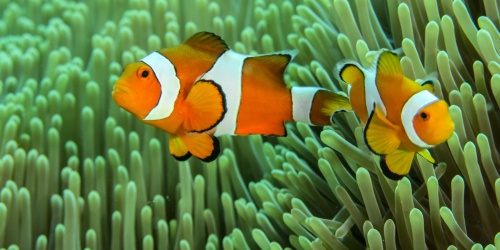
Seagrass - Photo divedog / Adobe
What are seagrasses? Unlike seaweeds, seagrasses are underwater plants that actually produce flowers and have root systems that grow on and stabilise sand. Seagrass beds may stretch for hundreds of kilometres in places like Shark Bay Marine Park and resemble meadows found on land. If you go out in a boat, take some time to look below the surface at these carpets of life.
Why are they important? Seagrasses provide an important food source and shelter a huge variety of other marine plants and animals such as tiny worms, shellfish, sea stars and crustaceans. These, in turn, attract larger animals and so begins a complex food web. Larger animals such as dugongs also graze directly on seagrass plants. Seagrasses provide nursery areas for species such as western rock lobsters, tiger prawns and herring that are important to our fishing industries. Seagrass meadows also help to stabilise the seafloor by trapping sediments.
What do seagrasses look like? The seagrass meadows in Western Australia are mainly ribbon weed (Posidonia spp.) and wireweed (Amphibolis spp.), though oval paddleweed (Halophila ovalis) and Tasman’s eelgrass (Heterozostera tasmanica) are also common. Ribbon weed has long ribbon-like leaves that provide a handy attachment point for many plants and animals. They have an extensive rhizome root system, with up to 90 per cent of the plant below the sand. Wireweed has branched woody upright stems up to two metres long, with clusters of leaves at the end of each branch.
Where do they grow? In Western Australia seagrass meadows are important features of the Shark Bay Marine Park, Jurien Bay Marine Park, Marmion Marine Park, Shoalwater Islands Marine Park and Ngari Capes Marine Park (which stretches from Busselton to Augusta), but they also grow in many other areas along our coast. Seagrasses grow in sheltered and shallow waters throughout the world, except of course for Antarctica. About 50 species of seagrasses grow worldwide. Australia has 31 species, more than any other continent, and 14 of these grow in the Perth region. New Zealand, in stark contrast to Australia, has only two species of seagrass growing in its waters.
Interesting facts: Western Australia’s unique Shark Bay Marine Park has the world’s largest meadows of seagrass and the largest number of seagrass species growing together in one place in the world. Ribbon weed produces flowers with both male and female parts. These flowers produce floating fleshy fruits from December to January which are washed up on beaches. Wireweed differs by having separate male and female flowers. The male flower releases pollen into the water column, which drifts until reaching a female flower. The seedling then continues to grow on the parent plant for several months until it breaks away to form a separate plant.
How you can help to protect seagrass: When out in a boat, you should always anchor in sand to help protect seagrass areas.



























